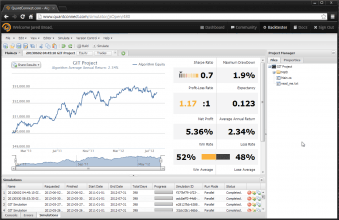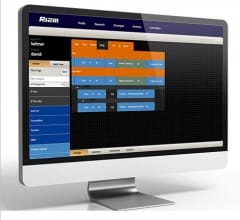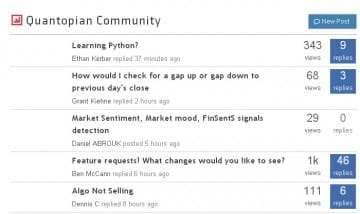One of the biggest stumbling blocks when it comes to programming and calibrating trading algorithms is the time it can take to back-test these strategies to see how well they work and identify potential problems. Even on a powerful desktop PC, a standard back-test can take several days to compute, which slows down the process significantly and makes it hard to evolve strategies in a timely fashion.

QuantConnect is one of a new breed of automated trading platforms that offers users the chance to backtest their algorithms on historical data quickly using cloud computing technology. Like the high-end OpenQuant platform, which we looked at in part 2 of this series, it uses the C# programming language for programming algorithms, which is an object orientated offshoot of the C/C+/C++ series of languages. This allows programmers to create much more complex algorithms than they might be able to in a dedicated algo trading language such as MQL4, for example, but the flipside of this is that the learning curve is a fair bit steeper.

Although it is primarily a free service, users who wish to put their scripts into practice on the markets can do so via a tie-in with Interactive Brokers. This is currently how the service is monetized, although there are plans to provide other paid services for investors such as a fund aggregating the most successful users of the platform.
Quantopian
This service launched around the same time as QuantConnect, and offers very similar facilities, with free backtesting on historical market data. It uses the popular programming language Python, for which there are many trading algorithms already available. The community aspect of the service is very up-front, with a stream of posts by programmers within the community visible on the homepage. At the moment, the historical data available is limited to stocks, although there are plans to introduce other asset classes including forex in the near future.
RIZM
Another recent entrant to the cloud-based algo programming environment arena is RIZM, from EquaMetrics Inc. Unlike many platforms that require users to code their own algorithms, RIZM provides a visual interface that makes it possible for traders and investors to create scripts without any prior programming knowledge or know-how. This interface, which is known as Algobuilder, allows users to simply drag and drop widgets to set key indicators, actions, and methods in a logical and intuitive way.

The service is charged on a monthly basis, although you can use it for free for two weeks on a trial basis. For $99 per month users can perform up to 100 back tests, run two live strategies simultaneously, and execute with 5 symbols per algorithm. For $249 per month, you can make unlimited use of the platform’s facilities. These prices put it into closer competition with platforms such as NinjaTrader and TradeStation than the free services offered by QuantConnect and Quantopian, but if you find the prospect of coding in C# or Python daunting, then it may be well worth the investment.
Other articles in this series:
- Guide to Automated Forex Trading Software Part 1
- Guide to Automated Forex Trading Software Part 2
- Forex Trading Automated Robots and Systems
- Advantages and Disadvantages of Automated Forex Trading
Tradersdna is a leading digital and social media platform for traders and investors. Tradersdna offers premiere resources for trading and investing education, digital resources for personal finance, market analysis and free trading guides. More about TradersDNA Features: What Does It Take to Become an Aggressive Trader? | Everything You Need to Know About White Label Trading Software | Advantages of Automated Forex Trading






































